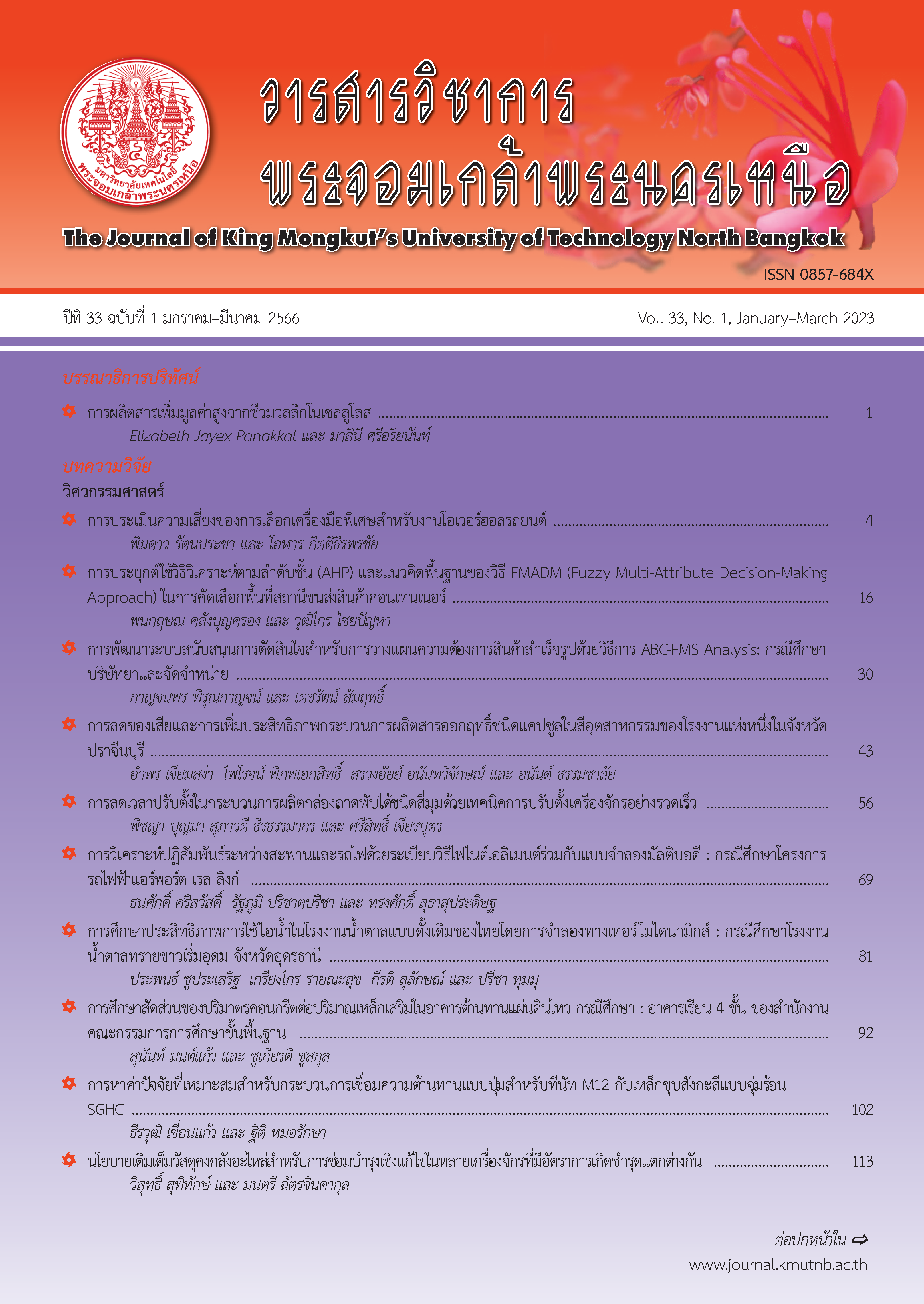นโยบายเติมเต็มวัสดุคงคลังอะไหล่สำหรับการซ่อมบำรุงเชิงแก้ไขในหลายเครื่องจักรที่มีอัตราการเกิดชำรุดแตกต่างกัน
Main Article Content
บทคัดย่อ
งานวิจัยทำการกำหนดนโยบายเติมเต็มที่เหมาะสมสำหรับวัสดุคงคลังอะไหล่ในงานซ่อมบำรุงเชิงแก้ไขของระบบที่มีหลายเครื่องจักรซึ่งมีค่าเฉลี่ยการเกิดชำรุดแตกต่างกัน การชำรุดของแต่ละเครื่องจักรมีการใช้วัสดุคงคลังอะไหล่ชนิดเดียวกันด้วยจำนวนที่แตกต่างกัน นโยบายเติมเต็มที่นำเสนอเป็นการคำนวณปริมาณเติมเต็มที่เหมาะสมสำหรับแต่ละรอบเวลาเติมเต็มซึ่งถูกกำหนดไว้ โดยมีวัตถุประสงค์เพื่อลดต้นทุนรวมของระบบ ซึ่งประกอบด้วย ต้นทุนวัสดุ ต้นทุนถือครอง ต้นทุนเสื่อมสภาพ และต้นทุนขาดแคลนวัสดุ จากลักษณะของนโยบายการสั่งซื้อตามรอบเวลา ปริมาณเติมเต็มวัสดุคงคลังมีค่าเท่ากับผลต่างของระดับวัสดุคงคลังสูงสุดและระดับวัสดุคงคลังคงเหลือที่ช่วงเวลาสั่งเติมเต็ม ระดับวัสดุคงคลังสูงสุดถูกกำหนดจากความน่าจะเป็นของการขาดแคลนวัสดุที่เหมาะสมซึ่งคำนวณโดยการหาอนุพันธ์ของสมการต้นทุนรวม คำตอบที่ได้จากตัวแบบการคำนวณที่นำเสนอถูกนำไปเปรียบเทียบกับคำตอบที่ได้จากการจำลองสถานการณ์มอนติคาร์โลที่ระดับแตกต่างกันของสามปัจจัย ประกอบด้วย จำนวนเครื่องจักร (2 ระดับ) ต้นทุนการขาดแคลนวัสดุ (3 ระดับ) และ อัตราชำรุด (3 ระดับ) จากผลการทดสอบปัญหา 18 กรณี ตัวแบบการคำนวณที่นำเสนอให้คำตอบเดียวกับการจำลองสถานการณ์ทุกกรณี โดยระดับวัสดุคงคลังสูงสุดมีแนวโน้มเพิ่มขึ้นที่ระดับสูงขึ้นของแต่ละปัจจัย
Article Details

อนุญาตภายใต้เงื่อนไข Creative Commons Attribution-NonCommercial-NoDerivatives 4.0 International License.
บทความที่ลงตีพิมพ์เป็นข้อคิดเห็นของผู้เขียนเท่านั้น
ผู้เขียนจะต้องเป็นผู้รับผิดชอบต่อผลทางกฎหมายใดๆ ที่อาจเกิดขึ้นจากบทความนั้น
เอกสารอ้างอิง
J. Poppy, R. J. I. Basten, R. N. Boute, and M. R. Lambrecht, “Numerical study of inventory management under various maintenance policies,” Reliability Engineering and System Safety, vol. 168, pp. 262–273, 2017.
F. W. Harris, “How many parts to make at once,” Factory: The Magazine of Management, vol. 10, no. 2, pp. 135–136, 1913.
A. Andriolo, D. Battini, R. W. Grubbström, A. Persona, and F. Sgarbossa, “A century of evolution from Harris's basic lot size model: Survey and research agenda,” International Journal of Production Economics, vol. 155, pp. 16–38, 2014.
E. A. Silver and H. C. Meal, “A heuristic for selecting lot size quantities for the case of a deterministic time-varying demand rate and discrete opportunities for replenishment,” Computers & Industrial Engineering, vol. 14, no. 2, pp. 64–74, 1973.
H. M. Wagner and T. Whitin, “Dynamic version of the economic lot size model,” Management Science, Journal of Operations Management, vol. 5, pp. 89–96, 1958.
B. Kader, D. Sofiene, R. Nidhal, and E. Walid, “Jointly optimal preventive maintenance under spare parts order strategy,” IFAC Proceedings Volumes, 2013, pp. 1376–1380.
B. Kader, D. Sofiene, R. Nidhal, and E. Walid, “Ecological and joint optimization of preventive maintenance and spare parts inventories for an optimal production plan,” International Federation of Automatic Control, vol. 48, no. 3, pp. 2139–2144, 2015.
Z. Hajej, S. Dellagi, and N. Rezg, “Optimal integrated maintenance/production policy for randomly failing systems with variable failure rate,” International Journal of Production Research, vol. 49, no. 19, pp. 5695–5712, 2011.
P. Penpakkol and T. Intarakumthornchai, “Inventory management of spare parts under uncertain demand: A case study of particle board manufacturer,” The Journal of KMUTNB, vol. 28, no. 1, pp. 9–22, 2018 (in Thai).
S. Puspitasari, S. Amanda, and E. Agustina, “Minimizing corrective maintenance cost through spare parts classification and inventory control,” in Proceedings of the 2019 1st International Conference on Engineering and Management in Industrial System, 2019, pp. 444–450.
R. J. Tersine, “Independent demand systems: Probabilistic model,” in Principles of Inventory and Materials Management, 4th ed. Englewood Cliffs, NJ: PTR Prentice-Hall, 1994, ch. 5, pp. 204–272.
S. Nahmias, “Reliability and maintainability,” in Production and operations analysis, 6th ed. Singapore: McGraw-Hill, 2009, ch. 12, pp. 700–753.
S. Wongmongkolrit, B. Rassameethes, and W. Supithak, “Spare parts management for corrective,” International Journal of Engineering Research & Technology, vol. 3, no. 12, pp. 1002–1006, 2014.
R. J. Tersine, “Single order quantities,” in Principles of Inventory and Materials Management, 4th ed. Englewood Cliffs, NJ: PTR Prentice-Hall, 1994, ch. 5, pp. 312–332.

